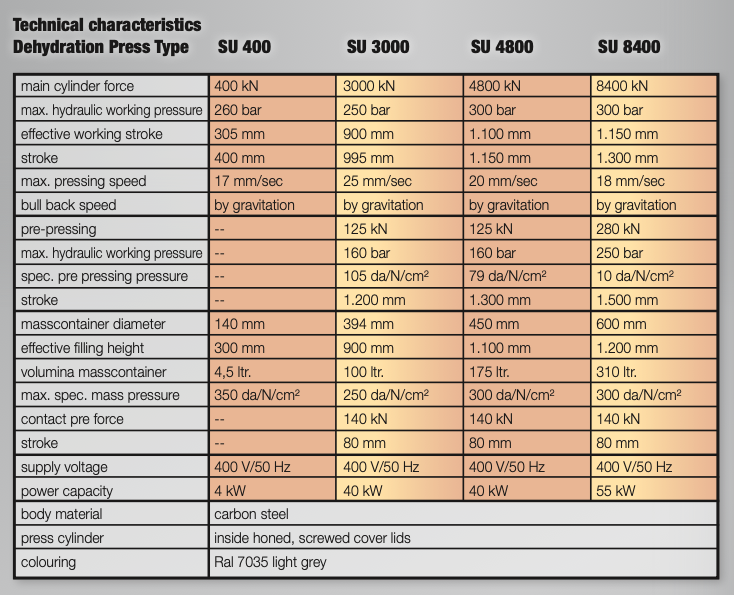BOWAS dehydration process
Main Operation
The dehydration press is used for displacing water by Ethanol for water wet NC raw material, as needed for the production of propellants.
Available Capacities
Dehydration presses are available for 400 kN, 3000 kN, 4800 kN and 8400 kN main cyl- inder force.
BOWAS is in a position to offer a modern, state of the art plant concept which fits into the concept of existing client’s plant sections actually under modernization and as stand alone solutions. The plant concept aims at offering the most economic solution which follow the client’s requirements. The main goal is to replace the maximum water content in the water wet NC by Ethanol.
The following process steps are done fully automatically and remote controlled:
During the manual filling of water wet NC into the dosing hopper metal parts will be removed by a metal separator immediately out of the downdraft.
After that the NC is weighed, dosed and fed by a screw conveyor in 3 to 5 portions into the mass container of the dehydration press. During feeding pro- cess the volume in the cylinder is compressed with the help of a pre-press cylinder to avoid adiabatic compression in the main press cycle as a safety aspect. After the correct amount of NC is filled into the mass container the volume will be continuously compressed by the main press ram.
The dehydration process is carried out in 3 main steps:
Step 1: Pre-compression with Ethanol injection with low mass pressure
Step 2: Main compression with Ethanol for displacing the water with increased pressure
Step 3: Dry pressing for the adjustment of the total remaining moisture
Ethanol/water mixture escapes through the retaining piece and the top of the cylinder. The percentage of ≤3% water is remain- ing in the final product, so called “cake” of Ethanol wet NC.
The cake is ejected on top of the cylinder and transported ideally via conveyor belt to the crusher room. There the cake will be shredded with the help of a bale breaker device with cutting mill and then stored in conductive barrels. These barrels get immediately closed with a lid, so the stored NC will keep the wanted solvent content.
Advantages of the process
Compared to other existing pressdehydration processes BOWAS offers the following advantages:
Safety – Special care has been dedicated to increase the safety of the dehydration process. All equipment has been designed and built in accordance with the latest and most advanced technology and is based on our extensive experience in the field of explosives and propellant production. An important increase in safety is achieved by remote controlled pressing stages. CCTV cameras are used for monitoring critical and hazardous operations where operating personnel is not allowed to be present during operation.
The process is designed with the necessary automation level in order to minimize the number of operating personnel in areas of potential risk. This also reduces the frequency and duration of the operators’ activities in these areas. The dehydration press is equipped with interlock- ing of doors and controls to safe- guard the remote operation and a double independent process control instrumentation may be installed additionally as an option. A metal detection of the NC cake, as well as ventilation arrangements are important for the safety. The floor has to be kept always water-wet. Going along with safety equipment BOWAS provides a detailed risk analysis, focusing the special demands of safety of the dehydration process, such as adiabatic compression of air and solvent vapour, presence of dry NC, overfilling of the press cylinder etc.
Ergonomics for the operating personnel in the different operation steps are improved by mechanized handling providing safety and cost effective production with known and tested technology.
Better economic results
The design and concept of the BOWAS dehydration process together with a high-level automation offer an optimum balance between investment costs and necessary personnel requirements. The equipment is de- signed for a high availability at low maintenance costs.
There is no other automatic process which results in such a high quality knot free final product which is the precondition for an excellent gelatinization dur- ing kneading process for Single base and Double base propellant production.
Compared to the pusher centrifuge system there are two big advantages:
• Residual water content ≤ 3%
• Ethanol consumption 5 -10 times less


